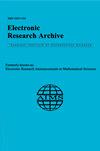Research on en route capacity evaluation model based on aircraft trajectory data
IF 1
4区 数学
Q1 MATHEMATICS
引用次数: 0
Abstract
For the sake of refined assessment of airspace operation status, improvement of the en route air traffic management performance, and alleviation of the imbalance of demand-capacity and airspace congestion, an en route accessible capacity evaluation model (based on aircraft trajectory data) is proposed in this paper. Firstly, from the perspective of flux, the en route capacity is defined and expanded from a two-dimensional concept to a three-dimensional concept. Secondly, based on the indicators of spatial flow and instantaneous density, an evaluation model of en route capacity is given. Finally, a case study is performed to validate the applicability and feasibility of the model. Results show that the en route accessible capacity, instantaneous density, and spatial flow can describe the temporal and spatial distribution of air traffic flow more precisely, as compared to the conventional indicators, such as route capacity, density, and flow. The proposed model envisages three innovations: (ⅰ) the definition of airspace accessible capacity with reference to capacity of road traffic, (ⅱ) the computation model for flux-based airspace accessible capacity and en route accessible capacity, and (ⅲ) two indicators of en route characteristics named instantaneous density and spatial flow are introduced for evaluating the micro-state of the en route. Furthermore, because of the capacity depiction of the spatial and temporal distribution of air traffic congestion within an airspace unit, this model can also help air traffic controllers balance the distribution of traffic flow density, reduce the utilization rate of horizontal airspace, and resolve flight conflicts on air routes in advance.基于飞机轨迹数据的航路容量评估模型研究
为了精细化空域运行状态评估,提高航路空中交通管理绩效,缓解需求容量失衡和空域拥堵,本文提出了一种基于飞机轨迹数据的航路可达容量评估模型。首先,从通量的角度对途中容量进行定义,并将其从二维概念扩展到三维概念。其次,基于空间流量和瞬时密度指标,建立了道路通行能力评价模型;最后,通过实例验证了模型的适用性和可行性。结果表明,与航线容量、密度和流量等常规指标相比,航路可达容量、瞬时密度和空间流量能更准确地描述空中交通流的时空分布。该模型提出了三个创新点:(ⅰ)参考道路交通容量定义空域通达能力;(ⅱ)基于通量的空域通达能力和航路通达能力计算模型;(ⅲ)引入瞬时密度和空间流量两个航路特征指标来评价航路微观状态。此外,由于该模型对空域单元内空中交通拥堵时空分布的容量描述,还可以帮助空中交通管制员平衡交通流密度分布,降低水平空域利用率,提前解决航线上的飞行冲突。
本文章由计算机程序翻译,如有差异,请以英文原文为准。
求助全文
约1分钟内获得全文
求助全文

 求助内容:
求助内容: 应助结果提醒方式:
应助结果提醒方式:


